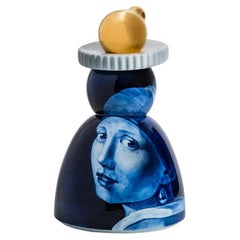Chris Koens
Recent Sales
2010s Dutch Modern Delft and Faience
Ceramic
A Close Look at Modern Furniture
The late 19th and early 20th centuries saw sweeping social change and major scientific advances — both of which contributed to a new aesthetic: modernism. Rejecting the rigidity of Victorian artistic conventions, modernists sought a new means of expression. References to the natural world and ornate classical embellishments gave way to the sleek simplicity of the Machine Age. Architect Philip Johnson characterized the hallmarks of modernism as “machine-like simplicity, smoothness or surface [and] avoidance of ornament.”
Early practitioners of modernist design include the De Stijl (“The Style”) group, founded in the Netherlands in 1917, and the Bauhaus School, founded two years later in Germany.
Followers of both groups produced sleek, spare designs — many of which became icons of daily life in the 20th century. The modernists rejected both natural and historical references and relied primarily on industrial materials such as metal, glass, plywood, and, later, plastics. While Bauhaus principals Marcel Breuer and Ludwig Mies van der Rohe created furniture from mass-produced, chrome-plated steel, American visionaries like Charles and Ray Eames worked in materials as novel as molded plywood and fiberglass. Today, Breuer’s Wassily chair, Mies van der Rohe’s Barcelona chair — crafted with his romantic partner, designer Lilly Reich — and the Eames lounge chair are emblems of progressive design and vintage originals are prized cornerstones of collections.
It’s difficult to overstate the influence that modernism continues to wield over designers and architects — and equally difficult to overstate how revolutionary it was when it first appeared a century ago. But because modernist furniture designs are so simple, they can blend in seamlessly with just about any type of décor. Don’t overlook them.
Finding the Right Delft-faience for You
The unique graceful design and classic style of antique Delft pottery and faience make these pieces an exceptional addition to any dining room.
The popularity of the blue-and-white porcelain developed in 14th-century China inspired Delft and faience pottery in Europe. The global expansion of trade through the Dutch East India Company led to the import of numerous examples of Chinese porcelain, resulting in the creation of Dutch Delftware, which is the term generally used to describe the tin-glazed earthenware that Dutch potters used. There were other imitations of Chinese porcelain produced by ceramicists throughout Europe, but Delftware was the most successful. This iconic tradition — the subject of a 2020 exhibition at the Kunstmuseum den Haag — resembled Chinese porcelain but was more affordable.
True blue Delftware originates only from a single location: Delft in the Netherlands. These precious pieces pair well with French faience. Unlike Delft plates, Delft vases and other pieces of Delftware, French faience utilizes a lead-and-tin glaze. This earthenware has roots in late-16th-century France. French Provincial Delft and faience tend to feature snow-white lacquered surfaces with colorful painted images or floral designs.
In terms of elegance and versatility, Baroque Delft and faience always impress. The most extravagant and boldly hued pieces are Rococo Delft and faience. Plates, tureens and other objects made in this style are frequently ornate and intricately decorated, making them ideal for display. Modern Dutch design masters often incorporate vintage decor into their contemporary designs, and Delftware items are a popular choice.
Browse antique Delft pottery and faience now on 1stDibs.
